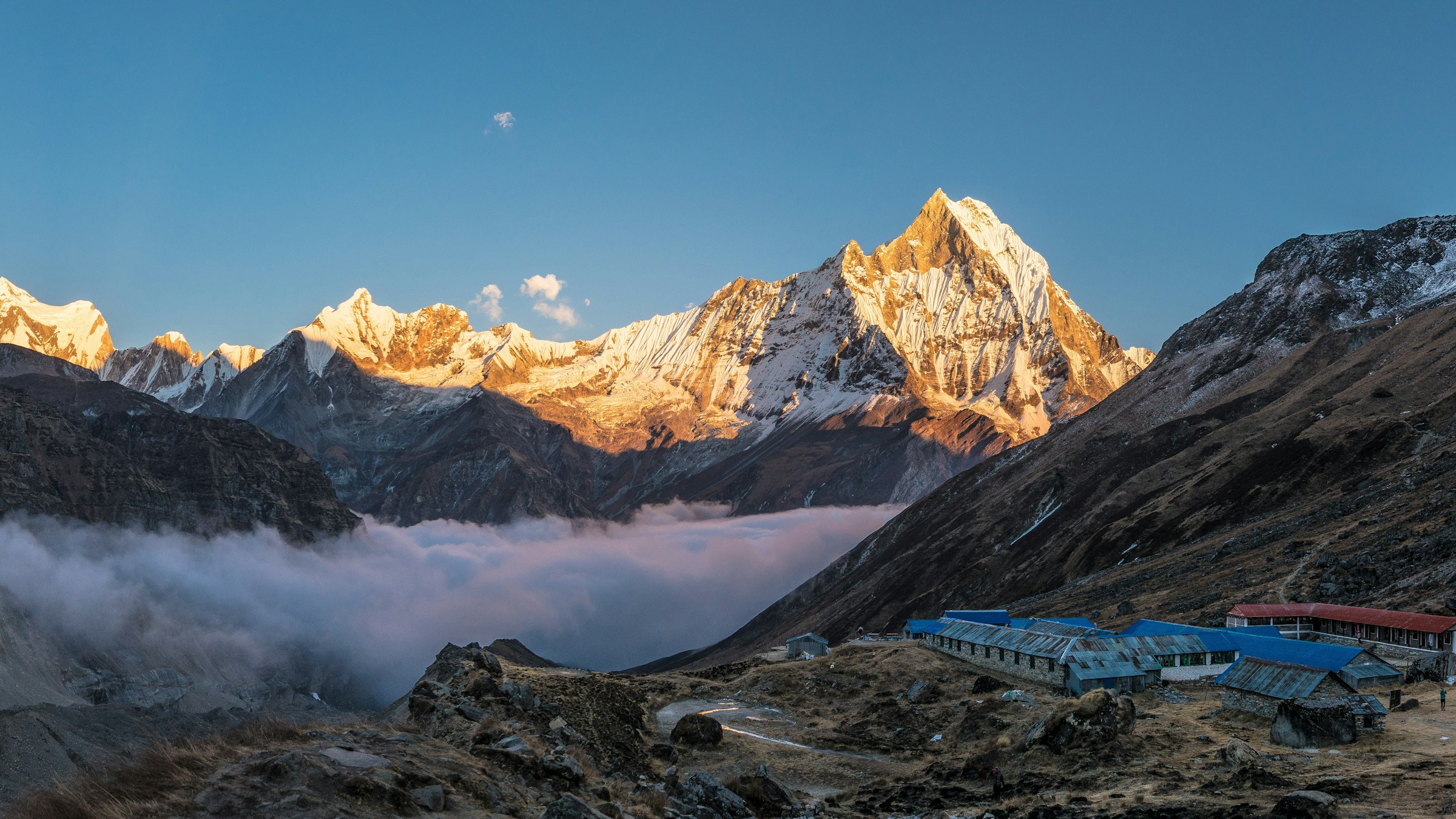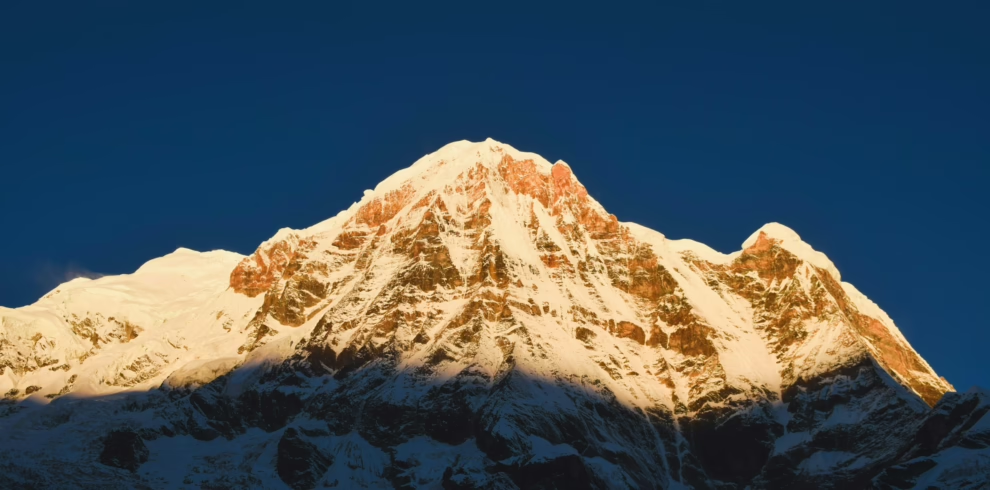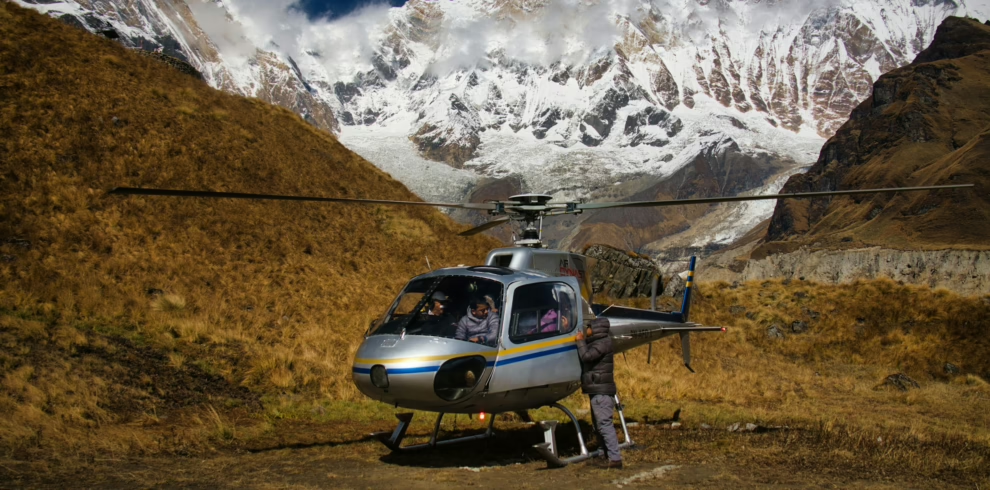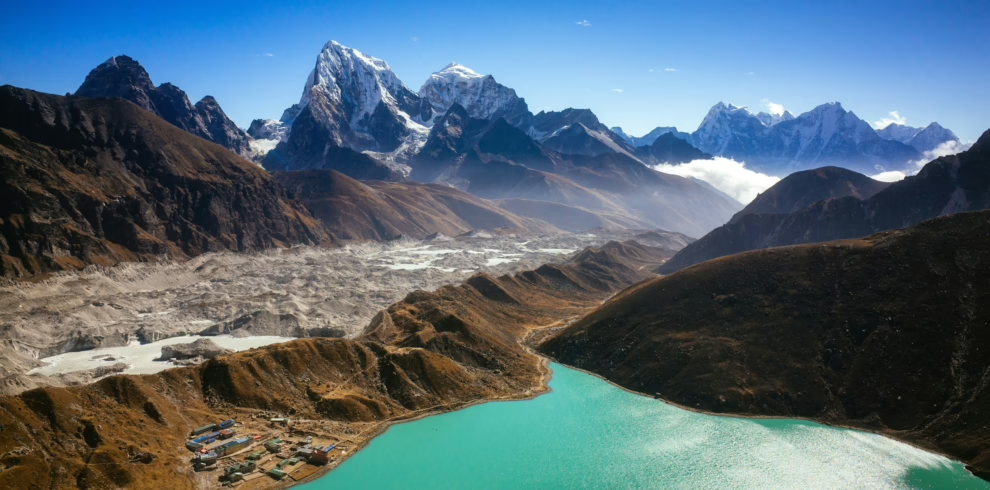If you’re dreaming about trekking through the stunning landscapes of Nepal, Green Lotus Trekking is here to turn that dream into reality. Whether you’re a first-time trekker or a seasoned adventurer, we offer a wide range of treks — from beginner-friendly routes to iconic trails in the Everest, Annapurna, and Langtang regions.
Already conquered the ABC Trek, EBC Trek, or the Annapurna Circuit? Looking for something new, less crowded, and closer to nature? We’ve crafted the perfect off-the-beaten-path adventure just for you — the North Annapurna Base Camp Trek, also known as the Maurice Herzog Trail. Discovered in 2019, this remote and scenic route combines raw Himalayan beauty with the thrill of camping in the wild.
Let 2025 be the year you go beyond the usual and dive into a trekking experience like no other.
12 days / 11 nights Annapurna North Base Camp trip
Discover Annapurna’s Soul On Your Journey
Highlights
- The North ABC Trek offers a moderately challenging adventure through the stunning natural landscapes of the Himalayas, rich with diverse flora and fauna.
- This trek combines teahouse stays and camping, providing breathtaking views of Annapurna I, Machhapuchhre, Himchuli, Nilgiri, and Dhaulagiri. Along the way, you'll journey through lush forests, encounter waterfalls, caves, glaciers, and relax in natural hot springs.
- A highlight of the trek is the visit to Narchyang Lake, which remains frozen during winter, creating a magical setting. With some luck, you may spot wildlife such as musk deer, snow leopards, bears, wild dogs, and blue sheep.
- The trek also offers a cultural experience, allowing you to explore the traditions and hospitality of the Magar and Thakali communities, and enjoy a rejuvenating soak in the hot springs of Tatopani.
Itinerary
Upon your arrival at Tribhuvan International Airport, our representative will greet you and transfer you to your hotel in a private tourist vehicle.
Once you're settled at the hotel, we will schedule a trip briefing at the hotel lobby or restaurant.
After an early breakfast, you will begin your 12-day North ABC Trek with a scenic seven- to eight-hour drive to Pokhara by tourist bus. Along the way, you'll enjoy views of the Trishuli and Marsyangdi rivers, lush mountains, winding streams, and small waterfalls. For an additional cost, you can opt for a 25-minute flight from Kathmandu to Pokhara, giving you more time to explore the Pokhara Valley.
After an early breakfast in Pokhara, you will travel to Tatopani by public bus or taxi. Located along the Kali Gandaki River, Tatopani is famous for its natural hot springs. If time permits, you can enjoy a relaxing bath here, or save it for your return. Your trek officially begins at Tatopani, with a two-hour hike to Narchyang Village.
As you gain elevation, accommodations become limited, with Upper Narchyang being the last village offering lodging. After breakfast, you will continue trekking toward Chhotepa. The trail is challenging, featuring rough mountain paths, slippery grassy sections, and stone steps. Along the way, you'll cross Lekhgaun, Ghalemdi, and Mristi Khola before reaching the Chhotepa campsite, where you will spend the night in a tented camp.
After breakfast at Chhotepa, you will begin your trek to Sandhi Kharka, covering nine kilometers in six to seven hours. The trail offers beautiful views of waterfalls and streams, making the journey truly rewarding. Along the way, you’ll pass through the picturesque village of Humkhola, another highlight of the North ABC Trek. Your overnight stay will be at a tented camp in Sandhi Kharka.
Today marks the most exciting part of your North ABC Trek as you reach Annapurna North Base Camp. The journey from Sandhi Kharka is both rewarding and challenging, requiring an uphill trek of about a kilometer.
You will cover 10 kilometers over 7 to 8 hours, enjoying breathtaking mountain views along the way. A knowledgeable guide from Green Lotus Trekking will help you find the best campsite at the base of Annapurna's northern face. You will spend the night in a tented camp at North Base Camp.
Spend the morning exploring North Annapurna Base Camp, surrounded by breathtaking views of Annapurna I, Mt. Fishtail, Himchuli, and Dhaulagiri. After taking in the stunning glaciers and nearby peaks, you will pack your gear and begin the trek back to Sandhi Kharka.
After breakfast in Sandhi Kharka, you will trek to Thulo Bugin, passing through lush rhododendron forests and crossing small streams. Along the way, you may spot a variety of wildflowers, birds, and other wildlife. Today's trek is shorter, taking about six to seven hours. You will spend the night at a tented camp in Thulo Bugin.
After breakfast, you will depart Thulo Bugin and head toward Lete, crossing the high Thulo Bugin Pass along the way. If time and fitness allow, you can take a detour to visit the beautiful Titi Lake. Depending on your pace, you may either continue downhill to Ghasa for the night or stay in Lete.
Today, you will take a local jeep back to Pokhara, marking the end of your trekking adventure. If the skies are clear, you’ll be treated to stunning views of the Annapurna Himalaya along the drive. Arriving early in Pokhara gives you time to visit the famous Phewa Lake, enjoy local street food, or even take a relaxing boat ride.
This morning, you will leave Pokhara and take a tourist bus back to Kathmandu, covering a scenic 205-kilometer journey along the Marsyangdi and Trishuli rivers. Along the way, you’ll pass through charming market towns like Damauli, Dumre, and Mugling.
Upon arrival in Kathmandu, a team member will meet you and transfer you to your hotel, giving you time to freshen up. You can then spend your final evening shopping or exploring Thamel, marking the end of your Annapurna North Base Camp Trek.
We will arrange your airport transfer approximately three hours before your scheduled departure. If you have extra time, we can organize additional side trips, or you are welcome to explore on your own.
Includes/Excludes
Cost Includes
- Airport Transfers: Private car service for pick-up and drop-off at Kathmandu International Airport.
- Accommodation: 3-star hotels for 2 nights in Kathmandu and 2 nights in Pokhara.
- Meals During Trek: 10 breakfasts, 8 lunches, and 7 dinners, with tea included along the trekking route.
- Trekking Accommodation: 2 nights in tea-houses and 5 nights in tents with all necessary camping equipment.
- Transportation: Round-trip shared tourist bus between Kathmandu and Pokhara.
- Guides and Cook: Licensed, English-speaking mountain guide and an experienced cook.
- Permits: ACAP and TIMS trekking permits for North ABC.
- Local Transfers: Shared bus or jeep from Pokhara to Tatopani.
- Trekking Staff Support: Medical and accident insurance, food, accommodation, and salaries for the trekking team.
- First Aid Kit: Fully stocked kit with an oximeter for monitoring oxygen levels and pulse.
- Taxes and Fees: All government taxes, VAT, and company service charges.
Cost Excludes
- Meals in Cities: Lunches and dinners in Kathmandu and Pokhara.
- Personal Expenses: Costs for battery charging, laundry, phone calls, and hot showers during the trek.
- Trekking Gear: Personal clothing and equipment, including sleeping bags and trekking shoes.
- Additional Costs: Drinks, bar bills, and other personal purchases.
- Domestic Flights: Kathmandu–Pokhara flight tickets.
- Insurance: Travel insurance covering emergency evacuation and rescue (must be arranged separately).
- Entrance Fees: Donations and monument entrance fees during the trek.
- Tips: Gratuities for guides, porters, and staff (optional but appreciated).
FAQs
Yes, travel insurance is required for this trek due to the high altitude and challenging terrain. Your policy must cover emergency evacuation, high-altitude trekking, and medical emergencies. Comprehensive insurance ensures your safety and provides peace of mind throughout the journey.
Trekking without a guide is not recommended due to the remote trails and limited facilities. A professional guide ensures your safety, helps navigate the complex route, and offers valuable cultural insights, greatly enhancing your overall experience and reducing risks.
The best time to trek is during spring (March to May) and autumn (September to November), when the weather is stable, the skies are clear, and temperatures are comfortable. It’s best to avoid the monsoon and winter seasons due to heavy rain, snow, and difficult trail conditions.
Up to Upper Narchyang, basic teahouses offer meals and lodging. Beyond that, camping is necessary, with meals prepared by the trekking crew. Trekking agencies provide all essential supplies and ensure comfortable camping arrangements.
The trek is demanding, requiring strong physical fitness and mental resilience. High altitudes, rugged terrain, and camping conditions increase the difficulty. Proper preparation and acclimatization are essential for a safe and enjoyable experience.
Yes, a TIMS card and an ACAP permit are required. These permits support safety measures and conservation efforts in the Annapurna region. Trekking agencies can help arrange them before your trek.
The trek starts from Pokhara, leading through Upper Narchyang and onto rugged mountain trails. Along the way, you’ll pass dense forests, alpine meadows, and high passes before reaching the base camp. Due to the remote and challenging terrain, hiring a guide is highly recommended.
Bring thermal clothing, waterproof gear, sturdy trekking boots, a sleeping bag, and trekking poles. Also pack personal essentials such as sunscreen, a first-aid kit, and required permits. For a complete list, consult your trekking agency.
Yes, beyond Upper Narchyang, the trek is fully camping-based due to the lack of teahouses. Professional agencies supply tents, meals, and all necessary camping gear, offering a deeper wilderness experience.
Focus on physical training, stay well-hydrated, and pack appropriately for high-altitude conditions. Proper acclimatization and hiring an experienced guide are essential for safety. Mental preparation for camping and rugged trails is also key to enjoying this unique adventure.
Before diving into the North ABC Trek, let’s explore its fascinating history — a journey that has gained popularity following the COVID-19 pandemic.
In 1950, a French expedition led by Maurice Herzog became the first to summit Annapurna I. Initially, the team considered both Annapurna and Dhaulagiri but ultimately chose Annapurna’s North Face, finding Dhaulagiri too challenging. Without supplemental oxygen, they reached the summit and faced a grueling descent, battling snowstorms, avalanches, and other hazards.
Today, the Annapurna North Base Camp Trek — also known as the French North Face Route — is attracting adventurous trekkers seeking less-traveled paths. Green Lotus Trekking has designed a special itinerary for those eager to explore the remote northwest side of Annapurna I.
This challenging trek offers stunning Himalayan panoramas and a rich natural and cultural experience. Highlights include natural hot springs, traditional Gurung villages, and views of iconic peaks such as Hiunchuli, Machhapuchhre (Fishtail), Dhaulagiri, Annapurna I, Nilgiri, and Annapurna South.
Despite its incredible diversity, the trail sees few visitors, offering a truly unique and unforgettable adventure.
The journey begins in Kathmandu, followed by a drive to Pokhara and then to Tatopani. From Tatopani, the trek follows Maurice Herzog’s historic route through Narchyang Village and Chhotepa, continuing to Sandhi Kharka and finally reaching Annapurna I North Base Camp (8,091m).
After exploring the base camp, the return route leads through Sandhi Kharka, Thulo Bugin, and Lete in Mustang, before driving back to Pokhara and Kathmandu.
Since there are no lodges along much of the route, this trek requires full camping support. Green Lotus Trekking provides experienced guides and Sherpas to ensure your safety and comfort. In spring and autumn, the trail is especially beautiful, with forests blooming in red, pink, and white rhododendrons. Lucky trekkers may also spot wildlife such as musk deer, blue sheep, bears, and even elusive snow leopards.
Benefits of Booking Annapurna North Base Camp Trek With Us
- Pickup and drop-off service at the trek’s start and end points
- Free Annapurna North Base Camp Trek map
- Oximeter to monitor blood oxygen saturation
- Medical kit for emergencies
What You Can Expect from the Annapurna North Base Camp Trek?
- Stunning views of the Annapurna, Nilgiri, and Dhaulagiri ranges, with a close-up of Annapurna I’s north face
- Trekking through the Annapurna Conservation Area, home to rare wildlife such as musk deer, snow leopards, bears, and blue sheep
- Cultural immersion with the Magar and Thakali communities, experiencing their traditions, cuisine, and hospitality
- Relaxation in Tatopani’s natural Himalayan hot springs
- Exploration of Phutphute Waterfall, a striking cascade flowing through a rock hole into a turquoise pond
- Journeys through lush forests, terraced farms, glacial lakes, alpine meadows, and rugged mountain trails
- High-altitude trekking across Thulo Bugin Pass and along the Miristi Khola river
Is Annapurna North Base Camp Trek Suitable For You?
- Ideal for adventurers seeking solitude in a remote and peaceful setting
- Perfect for camping enthusiasts who enjoy sleeping under the stars and the natural sounds of rivers and forests
- A rich cultural experience for those interested in the Gurung, Thakali, and Manangi communities
- A unique opportunity for wildlife enthusiasts to spot rare Himalayan species
- A paradise for landscape and wildlife photographers
- Suited for trekkers who prefer less-crowded, off-the-beaten-path trails
Preparation for Annapurna North Base Camp Trek
The trek is suitable for both novice and experienced hikers. However, seasoned hikers accustomed to walking 6–7 hours daily at altitudes above 3,000 meters may find it more manageable.
For first-time trekkers, preparation with regular cardio workouts and hill hikes is highly recommended.
While rated as moderate, this trek requires camping with limited facilities—expect to sleep in tents, eat basic Nepali meals, and use natural restrooms, unlike more developed trails like the Ghorepani Poon Hill or Mardi Himal Treks. Mental preparation is equally important. Be ready for basic living conditions, changing weather, and remote wilderness camping.
Remember: Good preparation can make all the difference for an enjoyable and successful high-altitude trekking experience.
Useful Information for Annapurna North Base Camp Trek
Best Time To Trek Annapurna North Base Camp
The ideal seasons for the Annapurna North Base Camp Trek are spring (March–May) and autumn (September–November).
- Spring offers clear skies, comfortable temperatures, and blooming rhododendron forests in vibrant colors, enhancing your camping experience.
- Autumn features excellent visibility, mild weather, and minimal rainfall, providing ideal trekking conditions.
While trekking in winter is possible for experienced hikers with proper gear, it can be challenging due to colder temperatures.
Accomodations During Annapurna North Base Camp Trek
- In Kathmandu and Pokhara, you’ll find everything from five-star hotels to budget guesthouses.
- At the trek’s start, Tatopani and Narchyang offer basic lodges and homestays.
- Higher up, there are no teahouses, and camping is necessary. Green Lotus Trekking will organize the campsites.
Foods and Waters Availability
- In Kathmandu, Pokhara, Tatopani, and Narchyang, you can enjoy a variety of cuisines (Nepali, Indian, Tibetan, Continental, and Western).
- During the trek, meals are basic, mainly Dal Bhat (rice, lentil soup, vegetables, and pickles).
- Drinking water is sourced from natural springs. Locals provide boiled and filtered water for a fee.
- Trekkers are advised to bring personal water purifiers (filters, UV purifiers, or chlorine drops) for safety.
Trek Difficulty
The Annapurna North Base Camp Trek is moderately difficult:
- Gradual ascent to 4,190 meters allows proper acclimatization.
- Hanging bridges over rivers like the Nilgiri reduce technical challenges.
- Being a camping trek, amenities are limited, and trekkers should prepare for basic living conditions.
- Long walking days, high altitudes, and remote camping will require good physical and mental endurance.
Travel Insurance for Annapurna North Base Camp Trek
We highly recommend purchasing comprehensive travel insurance that covers:
- Medical evacuation
- Trekking-related incidents
- Natural disasters
- Altitude sickness
- Theft, loss, or delayed baggage
Insurance ensures safety and financial protection in emergencies.
Packing Lists For Annapurna North Base Camp Trek
Camping Gear:
- Lightweight, 3-season tent
- Sleeping bag rated for -10°C to -15°C
- Insulated sleeping mat
Clothing:
- Moisture-wicking base layers
- Insulating fleece or down jacket
- Waterproof outer jacket and pants
- Warm hat and insulated gloves
- Sturdy, waterproof hiking boots
- Wool or synthetic socks (multiple pairs)
Cooking and Food:
- Lightweight portable stove (suitable for >4000m)
- Compact cookware set
- High-calorie, easy-to-cook meals
- 2-liter water bottle/bladder with purification method
Safety and Navigation:
- Map and compass or GPS
- Oximeter and first aid kit, including altitude sickness medication
- Headlamp with spare batteries
- Multi-tool or knife
- Sunscreen and lip balm (high SPF)
Other Essentials:
- 60–80 liter backpack
- Lightweight, anti-shock trekking poles
- Biodegradable toiletries (soap, toothbrush, toilet paper)






